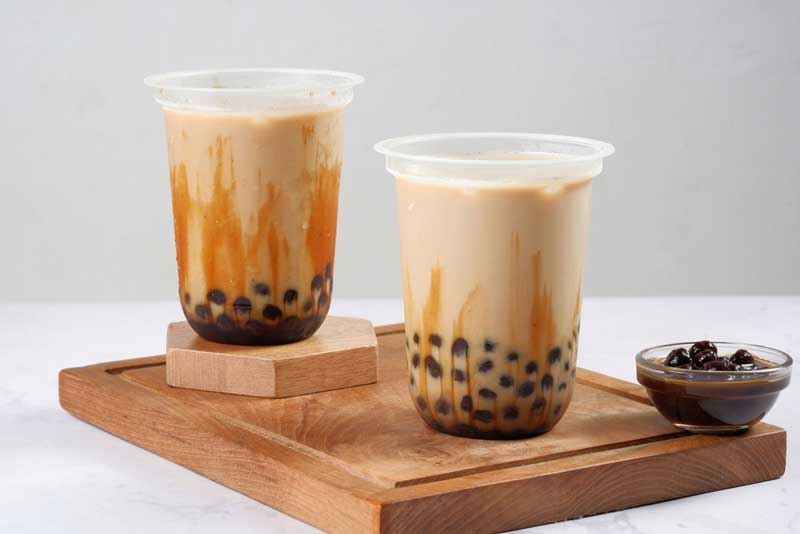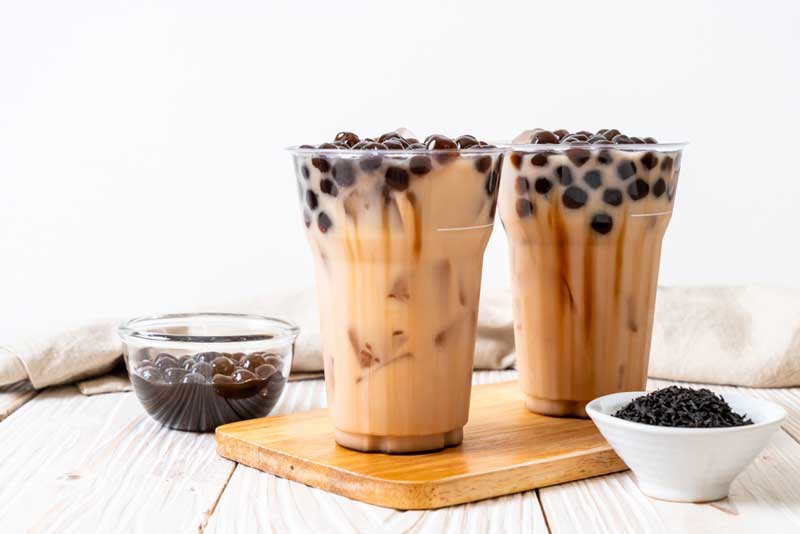Do you want an answer to the question, “Is Boba fish eggs?” If yes, then you are in the right place.
If you are a fan of bubble tea, you must have heard about tapioca pearls or boba, as we will be referring to it in this article. Bubble tea is a popular Taiwan drink with boba as one of its ingredients.
Now the question: what is boba? While some refer to boba as a fish egg, others see it as a jelly or fruit.
This article will discuss what boba is, what boba tastes like, and answer the question: is boba fish eggs? Read on to find answers that will satisfy your curiosity.
Boba: An Overview
In short, boba refers to cassava starch balls. In a broader context, it can encompass the entire drink (tapioca tea, pearl tea, or bubble tea, depending on your location) with its various toppings, with tapioca pearls being the most popular choice.
Tapioca pearls, or “boba,” are typically crafted from cassava starch, derived from a South American root vegetable called yuca. The inception of boba, encompassing both the drink and its signature pearls, traces back to Taiwan. Although the exact city and shop of its origin are debated, initially, boba pearls were featured in shaved ice desserts alongside chewy rice balls, beans, and syrups. The popularity of milk tea prompted someone to combine boba and milk tea, giving birth to the beloved drink we relish today.
Initially, boba was mostly sold in Taiwanese communities, near high schools and college campuses, as students were one of their consistent customers. Today, boba is sold in many shops around the country. They extend their hours into the late evening, offering affordable snacks and drinks, making them a prime destination for late-night hangouts and study sessions.
Is Boba Fish Eggs?
Now, the big question: is boba fish eggs? The answer is NO; boba is not fish eggs. Boba has no connections with fish, so ensure your beloved bubble tea without worrying about any fish content.
The fact that some people refer to boba as fish eggs might lead you to assume that there might be some relationship between boba and fish eggs. Like fish eggs, boba is small in size and has a similar texture.
Talking about their appearance, boba balls are slimy and see-through, just like edible fish eggs. However, it’s important to mention that boba is not fish eggs.
We can all sigh of relief knowing that our beloved bubble tea contains no fish eggs. The idea of tea made with caviar does sound quite unappetizing!
Also Checkout: Is Cinnamon Toast Crunch Vegan? (Everything to Know) And Is Red Bull Vegan? (Everything To Know)
What Does Boba Taste Like?
Boba tapioca pearls are usually used on drinks because of their unique texture instead of flavor, as boba tapioca pearls are not known for a strong flavor of their own.
The cooking method of boba pearls determines the experience you get from eating them; they can offer a subtle splash of flavor that delights the palates. Boba pearls simmered in a fruit-based syrup will adopt a fruity flavor, while those cooked in honey or sugar will carry a sweet taste.
Apart from their taste, they have a unique texture, which is slightly gelatinous and chewy. If you are trying to imagine the texture, think of how rice pudding that has not been fully cooked will feel like.
As we know, boba pearls are incorporated into milky tea to make bubble tea. The pearls provide a source to satisfy both thirst and hunger when you have a cup of tea.
Is Boba Vegan?
While it is implied boba is not vegan by the common belief that boba balls might contain gelatin, this is not the case. Despite their gelatinous texture, boba balls do not have any gelatin. This texture is achieved through gelatinization, wherein the balls are moderately heated, causing the outer layer to develop a soft, gel-like consistency.
All the ingredients used in boba tapioca pearls are crafted from plants, making them perfectly suitable for those adhering to a vegan diet. However, those who are lactose intolerant might want to avoid bubble teas as they are prepared with dairy milk. This will render them unsuitable for vegans, too.
It might delight you that reputable bubble tea establishments offer non-dairy milk alternatives to ensure everyone can relish this delicious drink.
Incorporating Boba into your Milk Tea

These cassava root balls shaped into bite-sized clusters, boiled, and flavored with brown honey or sugar are essential toppings in any tea shop. This results in a slightly sweet and chewy drink, making an addition to your drink that significantly elevates the enjoyment of milk tea. Make sure to add boba to your next cup of classic milk tea.
Some Toppings That Are Worth Trying at Boba Shops
- Taro balls: Taro balls dissolve gently in the mouth instead of the springy bounce mid-chew that boba pearls offer. The topping is crafted from taro, mixed with tapioca flour or sweet potato and water to form irregular-shaped spheres of delectability.
Taro balls are frequently enjoyed as a dessert in Taiwan served both hot and iced. Add them to your oolong milk tea for a delightful dessert-drink combination.
- Grass jelly: This topping has an ironic name as it is neither from grass nor tastes like grass. This treat is crafted from Chinese mesona, a plant related to the mint family. Brown sugar is added to grass jelly to improve its sweet taste. Grass jelly has a firmer texture than pudding and is cut into cubes. You can use grass jelly with coffee-based drinks. If you feel adventurous, use them instead of boba with milk tea; it is a fantastic alternative.
- Sago/tapioca: When it comes to taste, sago is similar to tapioca pudding if it is not there. In terms of texture, it is also similar to a tapioca pearl but is more spongy and chewy.
Sago and tapioca pearls are popular in many conventional Asian desserts and go well with matcha, red bean, and coconut flavors.
If you want to enhance your team experience without having to chew so much, you should go for sago or tapioca pearls.
- Aloe Vera: Aloe vera is another excellent topping to add to your drink. The taste of the aloe vera is usually enhanced with a syrup that brings out its refreshing taste. Not only does aloe vera enhance the taste of the drink it is added to, but it is also good for the skin and a good source of antioxidants. Passion fruit, orange, green tea, or citrus drinks are good selections for aloe veras as their tropical and bold flavors will boost the aloe vera’s subtle flavor.
- Pudding: Unlike the snack pack-style pudding, boba shops offer pudding that tastes like custard and is made from sugar, cream, egg yolks, and gelatin to make it firmer. Instead of the classic milk tea, you can try it with a creamer cup. Sometimes, boba shops offer flavored puddings, like mango or taro pudding. You can customize your drink to your liking or even add pudding on top of boba for a unique texture.
- Red bean: Red bean, or azuki bean, is an excellent option to try with match as this legume provides a fantastic fragrant and soft consistency with sugar-boiled. Do not hold back from trying this recipe because of the thought that beans and drinks do not go, as this red bean not only tastes great when prepped well but also provides you with needed fiber.
Frequently Asked Questions – Is Boba Fish Eggs?
Is Boba Made of Fish Eggs?
Boba is not made of fish eggs but tapioca starch crafted from cassava roots. This information might bring some relief if you are afraid of eating gelatin. Although they possess a gelatinous texture, they do not contain gelatin.
Is Popping Boba Fish Eggs?
If you get a cup of bubble tea and the boba pops in your mouth, you might wonder if they are fish eggs. Popping boba is made using a seaweed-based component known as agar agar. The resulting mix of the algae and a base liquid turns into little balls that resemble fish eggs.
Confirm the presence of honey in your popping boba, as that is the only thing that makes them unsuitable for vegans.
Are Boba Pearls Fish Eggs?
Boba in boba tea is made from cassava starch. Other famous names are tapioca balls and bubbles. Boba pearls can be made in unique ways depending on who is making them and the features that it is expected to have. None of these ways involve fish eggs; boba pearls are not fish eggs.
What Is Boba Made Of?
Boba, often called tapioca pearls, is created from tapioca starch, also known as cassava. These small spheres are typically cooked in brown sugar syrup, imparting them with a sweet taste and a black hue.
Also Read: Is Gochujang Gluten Free? (Everything To Know) and Is Granola Gluten Free? (Everything to Know)
Conclusion- Is Boba Fish Eggs?
So, is boba fish eggs? The answer is no.
Boba is usually associated with bubble tea and referred to as tapioca pearls. They are an excellent choice for bubble tea instead of fish eggs because of their unique texture.
Other alternatives to boba that you can use for your bubble tea include honey boba, sago pearls, and popping bubbles.
You can impress your friends with your new knowledge when you get bubble tea.

